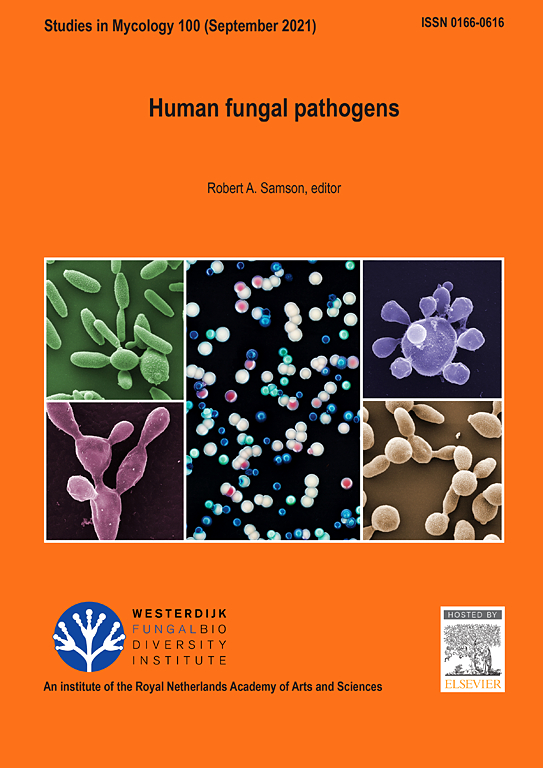具有重要生物技术价值的真菌亚门酵母菌的基因组信息高等级分类。
摘要
酵母菌亚门(subphylum Saccharomycotina)是真菌门(Ascomycota)中的一个分支,其基因组多样性水平与动植物相似。酵母菌亚门目前有 1200 多个已知物种,分为 16 科、1 目和 1 类。该亚门中的物种在生态和新陈代谢方面具有多样性,包括重要的人类机会性病原体以及在生物技术应用中非常重要的物种。许多具有生物技术意义的性状都存在于近缘物种中,而且往往局限于单一的系统发育支系。然而,大多数酵母物种的生物技术潜力仍有待开发。虽然酵母亚门的基因组序列进化速度远高于其姊妹亚门 Pezizomycotina,但与 Pezizomycotina 的 16 个类别相比,酵母亚门只包含一个类别。Ascomycota 的第三个亚门,Taphrinomycotina,包括 6 个类别,其物种数量大约是 Saccharomycotina 的 10 倍。这些数据表明,目前将所有这些酵母菌分为一个类和一个目是对其多样性的低估。我们之前进行的基因组规模的系统发育分析表明,酵母菌纲包含 12 个主要的、得到强有力支持的系统发育支系;其中 7 个是现存的科(唇形科、三叉科、藻类学科、藻类学科、藻类学科、酵母菌科和酵母菌科)、一个代表目前的两个科(Dipodascaceae 和 Trichomonascaceae),一个代表 Sporopachydermia 属,三个代表在翻译 CUG 密码子(CUG-Ala、CUG-Ser1 和 CUG-Ser2)时不同的品系。通过这些分析以及相对进化差异和基因组含量分析,我们提出了酵母菌纲的最新分类方法,包括可通过基因组含量进行诊断的 7 类和 12 目。这一更新的分类与该亚门中基因组的高度多样性相一致,而且对于使酵母菌亚门的高等级分类与其他真菌的高等级分类更具有可比性,以及对尚未正式命名的世系进行有效交流是必要的。新分类法:新类别:Alloascoideomycetes M. Groenew.Rokas, Dipodascomycetes M. Groenew.Rokas, Lipomycetes M. Groenew.Rokas, Sporopachydermiomycetes M. Groenew.Rokas, Trigonopsidomycetes M. Groenew.Rokas.New orders:Alloascoideomycetes:Alloascoideales M. Groenew.Rokas; Dipodascomycetes:Dipodascales M. Groenew.Rokas; Lipomycetes:Groenew., Hittinger, Opulente & A. Rokas; Lipomycetes: Lipomycetales M. Groenew.Rokas; Pichiomycetes:Alaninales M. Groenew.Groenew., Hittinger, Opulente & A. Rokas; Pichiomycetes: Alaninales M. Groenew.Rokas, Serinales M. Groenew.Rokas; Saccharomycetes:M.Groenew.、Hittinger、Opulente & A. Rokas;Saccharomycetes: Phaffomycetales M. Groenew.Groenew., Hittinger, Opulente & A. Rokas; Saccharomycetes: Phaffomycetales M. Groenew.Rokas; Sporopachydermiomycetes:Sporopachydermiales M. Groenew.Rokas; Trigonopsidomycetes:Groenew., Hittinger, Opulente & A. Rokas; Trigonopsidomycetes: Trigonopsidales M. Groenew.Rokas.New families:Alaninales:新科:Alaninales: Pachysolenaceae M. Groenew.Rokas; Pichiales:Pichiaceae M. Groenew.Rokas; Sporopachydermiales:Groenew., Hittinger, Opulente & A. Rokas; Sporopachydermiales: Sporopachydermiaceae M. Groenew.Rokas.引用:Groenewald M, Hittinger CT, Bensch K, Opulente DA, Shen X-X, Li Y, Liu C, LaBella AL, Zhou X, Limtong S, Jindamorakot S, Gonçalves P, Robert V, Wolfe KH, Rosa CA、Boekhout T, Čadež N, Péter G, Sampaio JP, Lachance M-A, Yurkov AM, Daniel H-M, Takashima M, Boundy-Mills K, Libkind D, Aoki K, Sugita T, Rokas A (2023).具有重要生物技术价值的真菌亚门酵母菌的基因组信息高等级分类。Doi: 10.3114/sim.2023.105.01 本研究献给酵母分类学先驱 Cletus P. Kurtzman(1938-2017 年)。The subphylum Saccharomycotina is a lineage in the fungal phylum Ascomycota that exhibits levels of genomic diversity similar to those of plants and animals. The Saccharomycotina consist of more than 1 200 known species currently divided into 16 families, one order, and one class. Species in this subphylum are ecologically and metabolically diverse and include important opportunistic human pathogens, as well as species important in biotechnological applications. Many traits of biotechnological interest are found in closely related species and often restricted to single phylogenetic clades. However, the biotechnological potential of most yeast species remains unexplored. Although the subphylum Saccharomycotina has much higher rates of genome sequence evolution than its sister subphylum, Pezizomycotina, it contains only one class compared to the 16 classes in Pezizomycotina. The third subphylum of Ascomycota, the Taphrinomycotina, consists of six classes and has approximately 10 times fewer species than the Saccharomycotina. These data indicate that the current classification of all these yeasts into a single class and a single order is an underappreciation of their diversity. Our previous genome-scale phylogenetic analyses showed that the Saccharomycotina contains 12 major and robustly supported phylogenetic clades; seven of these are current families (Lipomycetaceae, Trigonopsidaceae, Alloascoideaceae, Pichiaceae, Phaffomycetaceae, Saccharomycodaceae, and Saccharomycetaceae), one comprises two current families (Dipodascaceae and Trichomonascaceae), one represents the genus Sporopachydermia, and three represent lineages that differ in their translation of the CUG codon (CUG-Ala, CUG-Ser1, and CUG-Ser2). Using these analyses in combination with relative evolutionary divergence and genome content analyses, we propose an updated classification for the Saccharomycotina, including seven classes and 12 orders that can be diagnosed by genome content. This updated classification is consistent with the high levels of genomic diversity within this subphylum and is necessary to make the higher rank classification of the Saccharomycotina more comparable to that of other fungi, as well as to communicate efficiently on lineages that are not yet formally named. Taxonomic novelties: New classes: Alloascoideomycetes M. Groenew., Hittinger, Opulente & A. Rokas, Dipodascomycetes M. Groenew., Hittinger, Opulente & A. Rokas, Lipomycetes M. Groenew., Hittinger, Opulente, A. Rokas, Pichiomycetes M. Groenew., Hittinger, Opulente & A. Rokas, Sporopachydermiomycetes M. Groenew., Hittinger, Opulente & A. Rokas, Trigonopsidomycetes M. Groenew., Hittinger, Opulente & A. Rokas. New orders: Alloascoideomycetes: Alloascoideales M. Groenew., Hittinger, Opulente & A. Rokas; Dipodascomycetes: Dipodascales M. Groenew., Hittinger, Opulente & A. Rokas; Lipomycetes: Lipomycetales M. Groenew., Hittinger, Opulente & A. Rokas; Pichiomycetes: Alaninales M. Groenew., Hittinger, Opulente & A. Rokas, Pichiales M. Groenew., Hittinger, Opulente & A. Rokas, Serinales M. Groenew., Hittinger, Opulente & A. Rokas; Saccharomycetes: Phaffomycetales M. Groenew., Hittinger, Opulente & A. Rokas, Saccharomycodales M. Groenew., Hittinger, Opulente & A. Rokas; Sporopachydermiomycetes: Sporopachydermiales M. Groenew., Hittinger, Opulente & A. Rokas; Trigonopsidomycetes: Trigonopsidales M. Groenew., Hittinger, Opulente & A. Rokas. New families: Alaninales: Pachysolenaceae M. Groenew., Hittinger, Opulente & A. Rokas; Pichiales: Pichiaceae M. Groenew., Hittinger, Opulente & A. Rokas; Sporopachydermiales: Sporopachydermiaceae M. Groenew., Hittinger, Opulente & A. Rokas. Citation: Groenewald M, Hittinger CT, Bensch K, Opulente DA, Shen X-X, Li Y, Liu C, LaBella AL, Zhou X, Limtong S, Jindamorakot S, Gonçalves P, Robert V, Wolfe KH, Rosa CA, Boekhout T, Čadež N, Péter G, Sampaio JP, Lachance M-A, Yurkov AM, Daniel H-M, Takashima M, Boundy-Mills K, Libkind D, Aoki K, Sugita T, Rokas A (2023). A genome-informed higher rank classification of the biotechnologically important fungal subphylum Saccharomycotina. Studies in Mycology 105: 1-22. doi: 10.3114/sim.2023.105.01 This study is dedicated to the memory of Cletus P. Kurtzman (1938-2017), a pioneer of yeast taxonomy.

 求助内容:
求助内容: 应助结果提醒方式:
应助结果提醒方式:


